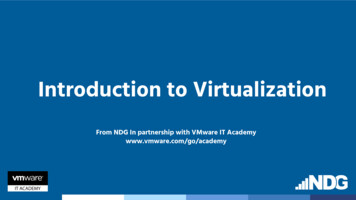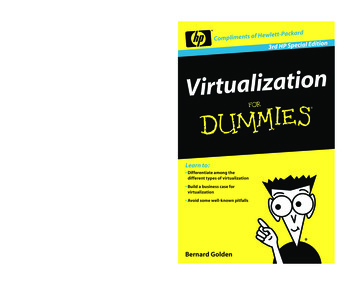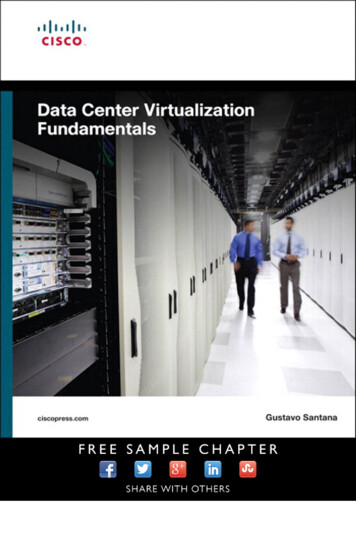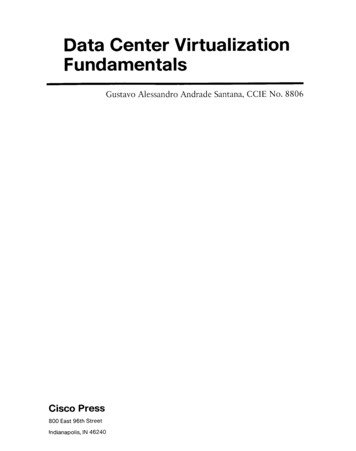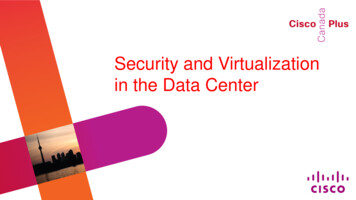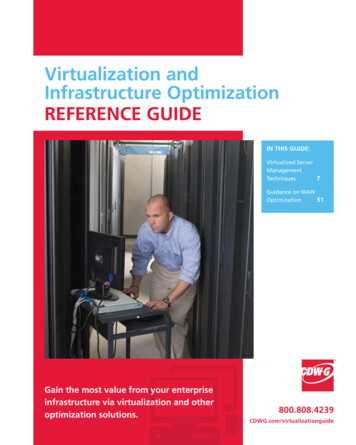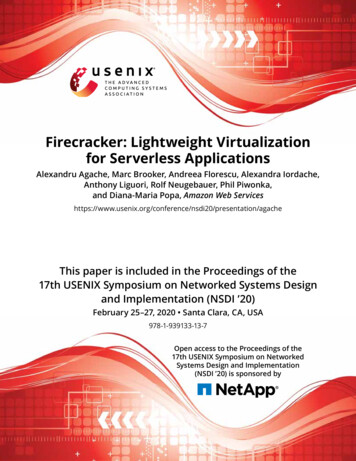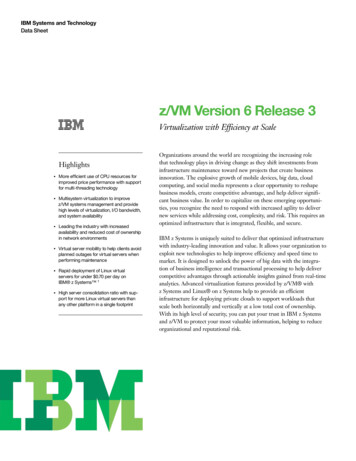
Transcription
IBM Systems and TechnologyData Sheetz/VM Version 6 Release 3Virtualization with Efficiency at ScaleHighlights More efficient use of CPU resources forimproved price performance with supportfor multi-threading technologyMultisystem virtualization to improvez/VM systems management and providehigh levels of virtualization, I/O bandwidth,and system availability Leading the industry with increasedavailability and reduced cost of ownershipin network environmentsVirtual server mobility to help clients avoidplanned outages for virtual servers whenperforming maintenanceRapid deployment of Linux virtualservers for under 0.70 per day onIBM z Systems 1High server consolidation ratio with support for more Linux virtual servers thanany other platform in a single footprintOrganizations around the world are recognizing the increasing rolethat technology plays in driving change as they shift investments frominfrastructure maintenance toward new projects that create businessinnovation. The explosive growth of mobile devices, big data, cloudcomputing, and social media represents a clear opportunity to reshapebusiness models, create competitive advantage, and help deliver significant business value. In order to capitalize on these emerging opportunities, you recognize the need to respond with increased agility to delivernew services while addressing cost, complexity, and risk. This requires anoptimized infrastructure that is integrated, flexible, and secure.IBM z Systems is uniquely suited to deliver that optimized infrastructurewith industry-leading innovation and value. It allows your organization toexploit new technologies to help improve efficiency and speed time tomarket. It is designed to unlock the power of big data with the integration of business intelligence and transactional processing to help delivercompetitive advantages through actionable insights gained from real-timeanalytics. Advanced virtualization features provided by z/VM withz Systems and Linux on z Systems help to provide an efficientinfrastructure for deploying private clouds to support workloads thatscale both horizontally and vertically at a low total cost of ownership.With its high level of security, you can put your trust in IBM z Systemsand z/VM to protect your most valuable information, helping to reduceorganizational and reputational risk.
IBM Systems and TechnologyData Sheetz/VM 6.3 is the premier virtualization platform, supportingmore virtual servers than any other in a single footprint. Itprovides industry leading capabilities to efficiently scale bothhorizontally and vertically, enabling clients to support growingbusiness demands while lowering the cost of service delivery.More efficient use of resources forimproved price performancez/VM provides support for multi-threading technology thatextends per-processor core capacity growth beyond singlethread performance for Linux on z Systems IFL workloads withsupport for two threads per core in IBM z13 (z13). z/VMmulti-threading technology support enables additional priceperformance benefits over previous hardware generations andmeets workload requirements transparently. This design allowsthe z13 to deliver additional capacity across a wide range ofCPU utilization for Linux and workloads, crucial for missioncritical applications and cloud service delivery.z/VM V6.3 multi-thread support increases the capacity ofz/VM to perform multiple units of work simultaneously. Whenmultiple virtual machines are active, multi-threading allowsmore of them to execute at the same time, increasing overallthroughput. This can lead to completing more transactions,faster response times, and increased resource utilization. Inaddition, z/VM multi-threading support is transparent toguests; no guest customization or exploitation is requiredWith the increase of business scale, workloads are continuingto grow in size, putting significant pressure on the resourcerequirements of virtual machines. z/VM 6.3 now supports up to1 TB of real memory to help clients keep pace with increasingbusiness demands while continuing to allow for the highestlevels of shared resource utilization. With a quadrupling of realmemory scalability, this support may increase server consolidation ratios while maintaining greater than 90 percent resourceutilization, unmatched in the industry for a multiple diverseworkload environment.In conjunction with multi-threading support, CPU scalabilityhas been enhanced in z/VM 6.3 to support up to 64 dispatchingunits. As a result, it supports up to 64 cores without multithreading enabled or up to 32 cores (and thus up to 64 threads)with multi-threading enabled.In addition to more memory, z/VM enhancements addressthe increasing workload demands for processor cycles and forquicker access to memory. z/VM HiperDispatch does that bystrengthening the affinity between where work is dispatched2
IBM Systems and TechnologyData SheetWithin a Single System Image, resources used by the z/VMhypervisors and the virtual machines are shared. This set ofshared resources can be managed as a single resource pool andprovides a more manageable infrastructure for cloud computing. These resources include User Directory, Minidisks, Spoolfiles and Network device MAC addresses. Sharing minidisksamong members improves the integrity and performance of thesystem. Through this sharing of resources, virtual servers haveaccess to the same devices and networks regardless of whichz/VM member they are logged on within the SSI cluster. Thefunctionality of the SSI environment provides the foundationfor Live Guest Relocation.and where the data used by that work exists, thereby avoidingdelays to retrieve that data. z/VM HiperDispatch is expected toprovide improved throughput depending on workload characteristics, with memory-intensive workloads running on largernumbers (16 to 32) of physical processors most likely to achievethe highest performance gains.With enhanced memory management support added inz/VM V6.3, z/VM can run efficiently in a configuration usingonly central storage. While expanded storage continues to besupported with a limit of 128 GB, its use is no longerrecommendedMultisystem VirtualizationThe VMSSI feature provides the basis for live guest relocationand extends the pool of resources that can be managed byadministering multiple instances of z/VM as if they are oneintegrated system. While VMSSI contributes to an optimizedsystem, tuned for the task of driving greater performance andefficiency for each Linux workload, base z/VM capabilityprovides a great deal more.Multisystem virtualization helps clients avoid the virtualmachine sprawl challenges of competitive systems and extendsz/VM virtualization technology to a new level allowing up tofour instances of z/VM to be clustered together as membersin a Single System Image (SSI). SSI is provided with theIBM z/VM Single System Image Feature (VMSSI) and extendsa fundamental strength of z/VM to share all system resourceswith very high levels of resource utilization.Live Guest RelocationThe most prevalent outage type in a z Systems environmentis for software or hardware maintenance or upgrades. TheIBM z/VM Single System Image Feature provides live guestrelocation, a process where a running virtual machine can berelocated from one z/VM member system of an SSI cluster toanother. Virtual servers can be moved to another LPAR on thesame or a different z Systems without disruption to thebusiness. Virtual servers can even be moved across theIBM z Systems family between IBM z13 (z13),IBM zEnterprise EC12 (zEC12), IBM zEnterprise BC12Simplified z/VM systems management is realized when z/VMinstances are members of an SSI cluster and can be serviced andadministered as one system. Coordination of members joiningand leaving the cluster, maintaining a common view of memberand resource states, and negotiating access to shared clusterresources are all done seamlessly. Servicing the z/VM softwarecomponents in an SSI cluster is simplified by using a singleservice stream for all members. Sharing service resources allowsservice to be rolled out to each member of the cluster onindividual schedules, avoiding an outage for the entire cluster.3
IBM Systems and TechnologyData SheetCPU pooling can also help control software costs when it isused to limit the amount of CPU resource consumed by groupsof virtual machines that run a licensed software product. If thecost of a software license is contingent on the associated number of CPUs or amount of CPU resource, then CPU poolingcan provide a basis for limiting that cost. Many IBM softwareproducts are offered using this licensing model. Some softwarevendors have different licensing models that might not bealigned with this approach, but the CPU pooling technologycould provide support for a new model if adopted.(zBC12), IBM zEnterprise 196 (z196), IBM zEnterprise114 (z114), IBM System z10 Enterprise Class (z10 EC ),and IBM System z10 Business Class (z10 BC ). This abilityto provide flexible workload balancing now allows work to bemoved to available system resources in addition to the longstanding capability to non-disruptively move system resourcesto work. This reduces the effect of planned z/VM outageswhen performing z/VM or hardware maintenance deliveringthe application continuity clients need.Optimized Systems for Improved SystemsManagement and Economicsz/VM V6.3 has been enhanced to provide guest support forthe IBM z Systems Data Compression (zEDC) Express feature.The data compression capability provided by zEDC Express isdesigned to offer industry-standard compression that supportscross-platform data distribution. Providing high-performance,low-latency compression without significant CPU overhead, italso helps reduce disk space requirements and improve channeland networking bandwidth.CPU pooling2 is designed to allow capping of CPU utilizationfor better systems management and resource consumption Itprovides a new way to control and limit the consumption ofCPU resources by assigning one or more virtual machinesto a CPU pool associated with a CPU utilization limit.A possible use of CPU pooling is to control the amount ofresource consumed by a set of related virtual machines. Forexample, when nightly backups are started simultaneously onseveral virtual machines, it might be desirable to limit theamount of CPU resource those backup tasks can consume to20% of CPU capacity.z/VM V6.3 has been enhanced to provide guest support forRemote Direct Memory Access over Converged Ethernetoffered by the 10GbE RoCE Express feature. This support isdesigned to help reduce latency and CPU resource consumption as compared to traditional TCP/IP communications,without requiring any application changes. The 10 GigabitEthernet (10GbE) RoCE Express feature is designed to helpreduce consumption of CPU resources for applications utilizingthe TCP/IP stack such as WebSphere Application Serveraccessing a DB2 database. The feature is also designed tohelp reduce network latency with memory-to-memory transfersutilizing Shared Memory Communications-Remote DirectMemory Access (SMC-R) in z/OS V2.1.Limiting CPU resources consumed by a department of yourorganization is another possible use of CPU pooling. Forexample, an agreement might specify the amount of CPUresource to which a department is entitled and for which theypay. Assigning specific virtual machines to a CPU pool canensure that the department does not consume more than theamount of CPU capacity agreed to.4
IBM Systems and TechnologyData Sheetenables z/VM utilization of greater than 90 percent of availablesystem resources which is unmatched in the industry for amultiple diverse workload environment.IBM z Systems with z/VM helps users optimize their spendingon software, staffing, energy, and floor space by deliveringsuperior resource sharing and virtualization efficiency. One ofthe greatest strengths of z/VM is its ability to share physicalresources among virtual machines. z/VM allows customersto virtualize processor, memory, communications, I/O, andnetworking resources to help reduce the need to duplicate andmanage hardware, programming and data resources. z/VM cansignificantly over-commit these real resources and allow usersto create a set of virtual machines with assets that considerablyexceed the amount of real hardware available.Meeting Customer Expectations forService LevelsEnsuring high availability and the quality of existing services isfundamental, but meeting customer expectations for real-time,dynamic access to innovative new services such as cloud placesrequirements for an innovative approach. Today’s security,resiliency, and compliance challenges need to be managedwhile also preparing for the new risks posed by an ever moreconnected and collaborative world. IBM z Systems with z/VM,with its superior IT optimization and consolidation capabilities,offers a clear advantage over competitive alternatives bydelivering better business value in these key areas.z/VM supports virtual networks to help reduce cabling, hubs,switches, and routers, as well as help to reduce maintenanceeffort. No physical cabling or external connections are requiredwith up to 32 independent, integrated, virtual local areanetworks (LANs) called HiperSockets . Linux guests are ableto communicate with hosts residing on both the same z Systemsserver and an external network through a single network interface, reducing configuration complexity. In addition, automaticfailover provides high availability when multiple HiperSocketsbridges are configured for a given HiperSocket LAN.Increased availability is achieved with z/VM support forz Systems dynamic reconfiguration, which features nondisruptive dynamic changes to the configurations of processors,channels, OSA network adapters, and memory to both thez/VM system itself and to individual guests, helping to reducethe requirement to re-IPL z/VM. Real and virtual memorymanagement is optimized for Linux and other guests, enablingadditional workloads to run simultaneously, supporting the needfor sizeable applications and expanding file systems.Enterprises that require multisystem server solutions will findthat z/VM can help them address their IT infrastructure needswith concurrent support for virtual machines running differentoperating systems in a secure isolated environment. z/VMsupports z/OS, z/VSE , z/TPF, and Linux on z Systemsoperating environments in addition to the CMS applicationdevelopment platform. The ability to support multiple machineimages and architectures enables z/VM to run multiple production and test versions of z Systems operating systems, all onthe same z Systems server, providing a highly flexible test andproduction environment. The test environment, which can bedesigned to reflect the server production environment, can helpsimplify migration from one release to another and facilitatethe transition to newer applications, providing a test systemwhenever one is needed. The efficient use of shared resourcesz/VM supports both the FICON Express16S feature forstorage area network (SAN) and the OSA-Express5S featurefor local area network (LAN) for single mode and multimodefiber environments.Reduced impact on active workloads with upgradeinstallation procedureClients can migrate from z/VM 6.2 to z/VM 6.3 in a shorterperiod of time with automation provided by a new simplifiedupgrade installation procedure. Automation eliminates the5
IBM Systems and TechnologyData SheetManaging Risk and Compliance withEnterprise Securityeffort required to copy and reconfigure your current environment and the hardware resources associated with migration.Taking advantage of live guest relocation in conjunction withsuch an upgrade can completely eliminate a planned outage ofactive workloads.Now more than ever you have to protect your business fromthreats large and small, from external and even internal sources.Designed to work with z Systems, z/VM provides advancedsecurity features that deliver value to the customer:Leading the industry with increased availability and reducedcost of ownership in network environmentsCommon Criteria certification5z/VM 6.3 provides Multi-VSwitch Link Aggregation Support3.This functionality, new with IBM z13, allows a port group ofOSA-Express features to span multiple virtual switches withina single z/VM system or between multiple z/VM systems.Sharing a Link Aggregation Port Group with multiplevirtual switches increases optimization and utilization of theOSA-Express when handling larger traffic loads. Higheradapter utilization protects customer investments, which isincreasingly important as 10 Gigabit deployments becomemore prevalent.The security certification of z/VM validates the security ofsensitive data and business transactions allowing you to runproduction servers side by side on the same machine with testand development servers. This can help to improve resourceutilization and offers significant operational benefits as well.Disk and tape encryptionTo help ensure your data-at-rest stays safe and secure, z/VMsupports the use of the IBM Full Disk Encryption features ofthe IBM DS8000 . z/VM also supports the ability of guests touse encrypted tape.Enablement support in z/VM allows Linux and z/OS gueststo exploit IBM z Systems High Performance FICON (zHPF).The zHPF architecture, an open standard, has been adopted byall enterprise-class storage vendors for DASD attachment toSystem z10 or later z Systems servers. By deploying zHPF,clients will see an immediate improvement in system resiliencebecause of its ability to handle I/O workload spikes. z/VMworkloads exploiting zHPF average a 35 percent increase in therate of I/O, an 18 percent decrease in service time per I/O, anda 45 to 75 percent decrease in the z/VM Control Program (CP)CPU per I/O4.SSL Server with FIPS certificationThe TCP/IP for z/VM SSL server is available to facilitatesecurity-rich and private conversations between z/VM serversand external clients. With new z/VM support for TLS 1.2 andSHA-2 hashing, a z/VM server can use the latest cryptographicprotocols in a FIPS 140-2 compliant mode to communicatesecurely with a client without a change to the server itself.The z/VM V6.3 System SSL module has been validated asconforming to the Federal Information Processing Standard 6. This industry-recognized cryptographic standard(FIPS) 140-2mandates modern digital key sizes and integrity checking forSSL and TLS operations. z/VM 6.3 System SSL is used byboth the z/VM LDAP Server and z/VM SSL-TLS Server.z/VM support for z Systems dynamic reconfiguration featuresalso allows the non-disruptive dynamic configuration of processors, channels, network adapters, and memory to individualLinux servers, helping to increase availability.6
IBM Systems and TechnologyData SheetCryptographic Accelerationapplications. The CPACF is used by SSL/TLS functionsincluded in the z/VM Lightweight Directory Access Protocol(LDAP) client and server, and by the SSL functions providedby the z/VM SSL server. Any virtual machine can access thefunctions of the CPACF by using the Message-Security Assist(MSA) extensions of the z Systems processor architecture.No explicit z/VM authorization or configuration is required.IBM z Systems Cryptographic features are designed to satisfyhigh-end server security requirements. They can be configuredas coprocessors for secure key transactions or as acceleratorsfor Secure Sockets Layer (SSL) communications, providingsignificant improvements in the performance of cryptographicalgorithms used for encryption and public-private key pairgeneration and verification.z/VM: A Key Cloud InfrastructureComponent with Open Stack Enablementz/VM makes the Crypto Express5S feature, a tamper-resistantcryptographic coprocessor, available to guests with eitherdedicated access for use in both secure-key and clear-key operations or with shared access for clear-key operations. z/VM canvirtualize z Systems cryptograph
Data Sheet. IBM Systems and Technology. IBM z Systems with z/VM helps users optimize their spending on software, staffing, energy, and floor space by delivering superior resource sharing and virtualization efficiency. One of the greatest strengths of z/VM is its ability to share physica
